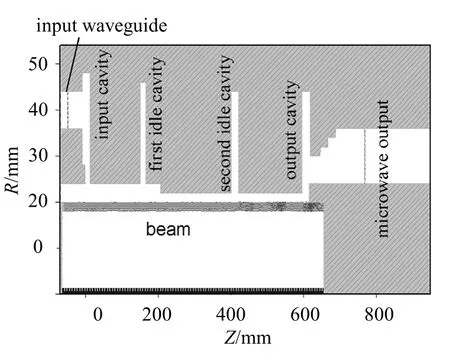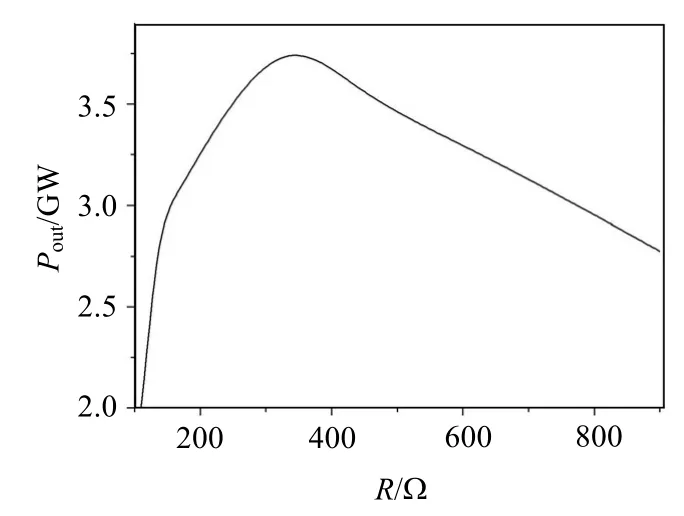四腔相对论速调管放大器的实验研究
四腔相对论速调管放大器的实验研究
针对杂频振荡的影响,在三腔相对论速调管的基础上发展了四腔高增益相对论速调管。采用PIC粒子模拟软件,从整管上对四腔强流相对论速调管放大器的冷腔结构、束波互作用、微波提取等方面进行研究。为得到输出功率和效率的最优值,结构上采用了低互作用输入腔,设计了阶梯状结构漂移管,通过对输出腔作用间歇进行优化处理等措施抑制了电子回流和杂频振荡的抑制,实现了器件在高增益下的GW级高功率微波输出。模拟表明整管微波模拟输出功率达3.05 GW、效率22%、增益63 dB(种子微波功率2 kW),该器件在实验上获得了增益为61.4 dB(种子微波功率1.38 kW)高功率微波放大输出,微波脉冲宽度大于100 ns。
高功率微波; 模式控制; 粒子模拟; 相对论速调管
High-power microwave (HPM) have important applications in the field of electronic countermeasures、radars、particle accelerators, and etc. There are several kinds of microwave devices for high power microwave (HPM) generators, such as relativistic klystron amplifier(RKA)[1-3], magnetron, backward wave oscillator (BWO)[4], traveling wave tube (TWT)[5], gyrotron, vircator[6], and transit tube oscillator[7]. Some of them are oscillators, and others are amplifiers. Amplifiers become increasingly important in HPM development because the power limitation become obvious for a single device in recent years, and the power adder with amplifiers is a better way to exceed this limitation. The relativistic klystron amplifier (RKA) is a typical device among HPM amplifiers[1,8]. Currently, the simple three-cavity klystron structure has been widely used because the oscillation of nonworking modes can be easily avoided in this structure[9]. But the gain of the three-cavity klystron is lower (30 dB), so it means that the seeding rf power ofMW level is required to obtain the output power at the level of GW.
And in a klystron amplifier, the idler cavity can efficiently increase the gain of the device,but it also cause oscillation of nonworking modes. Therefore, the non-working modes’ suppression in the four-cavity relativistic klystron amplifiers becomes very important[10-11]. Compared with the three-cavity relativistic klystron, the four-cavity relativistic klystron has advantages at the gain. With the gain of 60 dB, the seeding rf power of kW level can produce the output power at the level of GW, so it will greatly reduce the device’s size and cost. However, the nonworking modes’ oscillation will be easily excited in such structure, and the normal operation of the device is severely affected. To suppress nonworking modes’oscillation in the four-cavity relativistic klystron amplifier, this paper applies PIC simulation software to study the performance of the tube and optimize the structure.
1 Cold Cavity’s Parameters
The structure of a relativistic klystron amplifier composes of the input cavity, the idle cavity, the drift tube, the output cavity, and the rf absorber for non-working modes’ suppression. In this paper, in order to achieve the gain of more than 60 dB,two idle cavities (shown in Fig. 1) is used in the structure. The resonant frequency of each cavity is shown in Table 1. In Table 1, two idle cavities’ resonant frequencies are different, there are two reasons: 1) the gap voltage in the second idle cavity will be tuned to the required value due to such difference, 2) the structure’s frequency band can be broadened. And the resonant frequency of the output cavity is kept to be the same with the operating frequency. Meanwhile, the Q value of the output cavity should be moderate. The field strength in the cavity gap will be too small for the output cavity to exchange energy with the bunching electronic beam effectively if the Q value is too low. On the other hand, the field of gap will be too high and make too many electrons’ returning if the Q value is too high. In this paper, Q value of the output cavity is 11.15.

Table1 Frequency and Q value of the cavities

Fig.1 Structure of a four-cavity relativistic klystron amplifier
2 Beam-Microwave Interaction
Fig.1 shows the geometry structure used for simulations. The injection microwave power is 2 kW at the frequency of 2.88 GHz. Electron beam’s parameters are current 15 kA and voltage 1.2 MV. And the guide magnet field is 1T. Changes of the fundamental harmonic modulated current amplitude vs axis Z are shown in Fig.2. After the electron beam passes through input cavity gap, we achieved a fundamental modulated current of 51 A and modulation depth is 3.4% at 138 mm away from the input cavity as shown in Fig.2. After optimizing the distance between the input cavity and the first idle cavity, we achieved a fundamental modulated current of 325 A and modulation depth is 21% at 258 mm away from the first idle cavity. After optimizing the distance of two idle cavities, the modulation depth can reach 75% at the output cavity (as shown in Fig. 2).

Fig.2 Fundamental modulated current vs axis Z
3 Mode Control
In order to suppress the nonworking modes’oscillation, we have studied the relation between the output cavity gap voltage and the beam modulation depth. According to the equivalent circuit of the output cavity[4], the output cavity gap voltage is given by:

Here I1is the fundamental current of electron beam, R is shunt impedance of output cavity, and M is the coupling coefficient. And the cavity shunt impedance R directly reflects efficiency of the interaction between cavity field and electron, and is given by[5]:

Here PSrepresents the internal power loss of the resonator, and P the output power of the output cavity. Effects of beam modulated depth and gap impedance on the output power are shown Fig.3 and Fig. 4. In Fig.3 and Fig. 4, the output power reaches the maximum value when R andis optimized. That’s mainly because the gap voltage may be too large (according to Equ. (1) and Equ. (2)) when the gap impedance R or beam modulation depthis too large.
Effects of changes about the distance between the beam and the drift tube wall to the output microwave are listed in Table 2. It is shown that electron reflection can be effectively suppressed by increasing distance D between the beam and drift tube wall. The phenomena can be explained by the coupling coefficient M decreasing and the beam-microwave interaction reducing. In order to suppress the electron returning and increase the output microwave power, the distance between the beam and the drift tube wall before second cavity is chose to be 2 mm as shown in Fig.1. According to the effect of the above parameters' (R、1i and D) on the output microwave power, we have also optimized the structure by PIC simulation codes. We obtained a stable output microwave with the power reaches 3.05 GW, efficiency of 22%, and gain of 63 dB when the seeding rf power is 1.5 kW.

Fig.3 Effects of beam modulation to the output power

Fig.4 Effects of gap impedance to the output power

Table 2 Effects of changes about distance between the beam and drift tube wall to the output microwave
4 Experiments
The experiment is performed on the Linear Transformer Driver (LTD) accelerator, which can operate in the single pulse regime at a maximum voltage of 950 kV with pulse duration of 150 ns. The seeding rf power for the high gain RKA is an S-band klystron with a peak power of 5 kW and frequency of 2.86 GHz. Under conditions of the beam voltage of 900 kV, and the current of 8 kA, we have investigated the influence of the input RF power on the output power. The output power will be saturated when the input RF power is more than 1.5 kW, the maximum output power reaches 3.05 GW with the input power of3 kW, and the corresponding gain is 60 dB. With the input rf power of 1.38 kW, the maximum radiation power reaches 1.9 GW and the gain is 61.4 dB.
Fig.5 is the waveform and spectrum of the output microwave with the input power of 1.38 kW in the experiment. It can be observed that there is no other frequency in the spectrum as shown in Fig.5. Typical waveforms of the diode voltage, diode current, and the output microwave signal measured in the radiation field are shown presented in Fig.6. The gain of 61.4 dB (the seeding rf power 1.38 kW) is achieved in the experiment, and its pulse duration is more than 100 ns.

Fig. 5 Waveform and spectrum of the output with input power of 1.38 kW

Fig.6 Waveforms of the diode voltage, diode current, and microwave detector signal
5 Conclusion
By using the 2.5-dimensional particle simulation software, we have designed a four-cavity relativistic klystron for a high gain amplifier and have analyzed the high-frequency performance of the klystron. With the seeding microwave of 2.86 GHz frequency and 1.5 kW input power, we have obtained output microwave with power of 3.05 GW, efficiency of 22%, and gain of 63 dB. The corresponding experiment is carried out on the LTD accelerator. With the seeding microwave of 2.86 GHz frequency and 1.38kW seeding rf power, the gain of 61.4 dB and the output power of GW level are experimentally achieved without the nonworking mode excitation.
[1] BENFORD J, SWEGLE J A, SCHAMILOGLU E. High power microwaves[M]. London: CRC Press, Taylor and Francis Group, 2007.
[2] KLIMOV A I, KURKAN I K, POLEVIN S D, et al. A multigigawatt X-band relativistic backward wave oscillator with a modulating resonant reflector[J]. Technical Physics Letters, 2008, 34(3): 235-237.
[3] XIAO R, CHEN C, DENG Y, et al. An X-band overmoded relativistic klystron[J]. Physics of Plasmas, 2014, 21(11): 1131011-1131016.
[4] LI Zheng-hong, ZHOU Zhi-gang, QIU Rong. Beam-loaded frequency shift study in an over-sized backward wave[J]. Physics of Plasma, 2014, 21(10): 1031051-1031056.
[5] LI Zheng-hong, ZHOU Zhi-gang, QIU Rong. Influence of beam-loaded effects on phase-locking in the high power microwave (HPM) oscillator[J]. Physics of Plasma, 2014, 21(6): 0631011-0631016.
[6] CLEMENTS K R, CURRY R D, DRUCE R, et al. Design and operation of a dual vircator HPM source[J]. IEEE Transactions on Dielectrics and Electrical Insulation, 2013, 20(4): 1085-1092.
[7] LING J, ZHANG J, HE J, et al. A novel coaxial Ku-band transit radiation oscillator without external guiding magnetic field[J]. Physics of Plasmas, 2014, 21(2): 023114(1-7).
[8] WILSEN C B, LUGINSLAND J W, LAU Y Y, et al. A simulation study of beam loading on a cavity[J]. IEEE Transactions on Plasma Science, 2002, 30(3): 1160-1168.
[9] ZAITSEV N I, GVOZDEV A K, ZAPEVALOV S A, et al. Experimental study of a multimegawatt pulsed gyroklystron[J]. Journal of Communications Technology and Electronics, 2014, 59(2): 164-168.
[10] BATISCHEV D V, PAVLENKO A V. On designing electromagnetic drives operating under conditions of high vibrations[J]. Russian Electrical Engineering, 2012, 83(8): 423-431.
[11] VINTIZENKO I I. Modifications of a relativistic magnetron[J]. Technical Physics, 2014, 59(1): 113-118.
编辑税 红
廖 旭, 李正红
(西南科技大学理学院 四川 绵阳 621010)
date:2014 − 04 − 24;Revised date:2015 − 01 − 06
Supported by the National Natural Science Foundation of China under Grant(61271109)
TN61; O53
A doi:10.3969/j.issn.1001-0548.2015.04.009
2014 − 04 − 24;
2015 − 01 − 06
国家自然科学基金(61271109)
Biography:LIAO Xu was born in 1961, male, professor, his research interest includes electromagnetic field and microwave theory.
廖旭(1961 − ),男,教授,主要从事电磁场及微波方面的研究.

